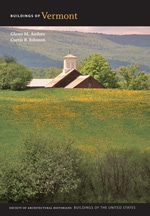
At the headwaters of Fay Brook above the White River, Daniel Richardson established this farm around 1817. As his sons and daughters developed the neighborhood in the coming years, it became known as the Richardson district. His son Hiram built the two-story, wood-frame central-hall house adjacent to his father's one-and-a-half-story Cape. Though it was a common practice for several generations and siblings to share a farm, here father and son were in unusual proximity, especially after the houses were joined by a porch. In the early twentieth century, William Richardson reorganized the barnyard, erecting a ten-sided barn built of spruce and hemlock harvested from trees on the farm, hauled to the sawmill, and brought back as lumber. Richardson, or his builder, was likely responsible for this original design, which has eighteen-foot-high walls, a simple low-pitched conical roof, and a ten-sided cupola, all with fixed two-pane sash windows. Although this old-fashioned “round” barn was probably the last raised in Vermont, Richardson's bank barn design was decidedly modern, with a ground stable and concrete foundation, an attached but separate milkhouse, and access for trucks at each level. The Richardson family still uses the barn for sheep and cattle.














